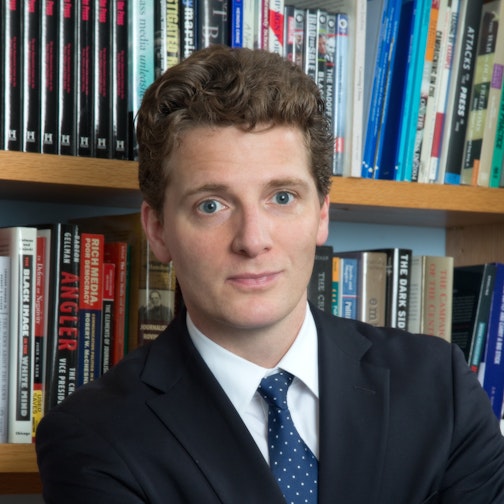The Polarization Trap
A Disappearing Center is Bad News for Liberals
-
-
Share
-
Share via Twitter -
Share via Facebook -
Share via Email
-
With the GOP threatening in November to gain seats in both the House and the Senate, many liberal activists and commentators are likely to continue to point to changing demographic trends as a sign that the electoral setback is a temporary blip, reflective of the predictable electoral swing against an incumbent President's party during his second term and a particularly unfavorable mix of world events and domestic conditions.
Many will also continue to blame a perceived political spending advantage on the part of conservatives including the growing network of groups funded by the billionaire Koch brothers.
For these liberal activists, donors, and fundraisers, November's electoral defeats will just be another point of evidence that they need to dedicate themselves to raising ever greater sums of money and invest in even more aggressive forms of "in your face" activism on issues ranging from climate change to social inequality.
Among the perceived encouraging trends that liberals are likely to point to are survey findings this past summer from the Pew Research Center showing that over the past twenty years the number of Americans who can be rated as "consistently liberal" in their worldviews has increased four fold, from 3 percent in 1994 to 12 percent today.
In a country considered center-right, 34 percent of Americans today score as consistently/mostly liberal in their outlook compared to 27 percent as consistently/mostly conservative, a reversal from 20 years ago.
Moreover, those in the middle (e.g. who can't be classified in either ideological camp,) have declined over the past decade by 10 points to 39 percent.
It's not only that Americans have grown more divided in their worldviews, but the constant demonization and outrage expressed at liberal and conservative media outlets, blogs, and by political leaders and commentators has cultivated deeply unfavorable views of the "other," to the point that according to Pew, a third of Democrats and Republicans believe that the other side is a "threat to the future of the country."
For liberals, who have purposively invested over the past 15 years in an ideological message machine of closely aligned media organizations, think tanks, bloggers, donor networks, and activist groups to rival that of the Right, the Pew poll findings are likely to be perceived as demonstrating the effectiveness of such echo chamber efforts.
To be sure, demographic changes and geographic sorting/mobility play a role, but for many liberal strategists and activists the intense polarization and antipathy for the "other side" reflected in the Pew findings will likely be cited as an example of successful movement building.
But such an attribution overlooks how the liberal and conservative movements fundamentally differ. For liberals, the more polarized the country becomes, the more difficult it will be to enact major policy changes or to hold together a successful electoral coalition.
For conservatives, on the other hand, increasing polarization favors their goals of downsizing government, blocking policy reforms, and limiting political participation among young people and minorities.
In a 2012 article at The Breakthrough Journal co-authored with the University of Wisconsin's Dietram Scheufele, we traced the origins of today's gridlocked, polarized politics and the impact on public opinion, voter participation, and political culture.
As we warned, the dysfunction, distrust, and disgust with government and politics that the liberal and conservative message machines have produced disproportionately harms liberals, whose core social and political objectives almost always entail public support and belief in the importance of government services, investments, and interventions in private markets.
Indeed, on the complex challenge of combating climate change and transitioning to cleaner energy sources, where ideas, policy approaches, and compromise from the left and the right will be needed to make substantial progress, the increasing unwillingness of liberals and conservatives to give ground in these debates is only likely to seed further dysfunction and disillusionment. 
Moreover, as we explained, though liberals benefit from rising cohorts of young, female, and minority voters who tend to favor Democratic candidates in elections, today's dysfunctional political culture and aggressive activism likely breeds further disengagement among these key constituencies.
As a consequence, Democrats and liberal groups are forced to spend record sums of money in Presidential campaigns to turn out these voters via social media and narrowly targeted appeals only to lose their interest and support in Midterm elections.
Indeed, as the Pew poll shows -- and as we suggested based on other research -- those who vote, participate, and express their opinion in politics are with growing intensity representative of a U shaped curve comprised of tail end ideological perspectives.
The result is likely to be ever strengthening engagement and participation among the most ideological in society, and spiraling disengagement among everyone else.
As we detailed in the Polarization Paradox essay, today's news and opinion culture along with major changes in digital and social media technology, has made it all too easy for strong partisans to seek out and engage with viewpoints that reinforce their opinions rather than challenge them.
This tendency towards ideological self-selection and self-censorship is highlighted in the Pew study findings as well.
In all, these trends are still only leading indicators of more ideological cleavage and divergence to come among the U.S. public, as ultra-wealthy donors, activist groups, think tanks and news organizations on the right and the left invest ever more heavily in demonizing the other side and making it easier for like-minded readers and viewers to opt out of cross-cutting news and discussion that challenges their views.
See Also:



